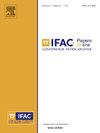用狄拉克点逼近化合物交换单元
Q3 Engineering
引用次数: 0
摘要
单细胞或高等生物之间通过扩散化合物进行通讯是生物系统中的一个重要现象。因此,建模经常发生,最直接的是通过在单元边界处具有适当通量边界条件的扩散方程。当有许多细胞时,这样的模型将变得计算效率低下和分析复杂,当它们移动时更是如此。我们建议考虑一个点源模型。每个细胞实际上被简化为一个点,并以位于细胞中心的狄拉克δ“函数”(测量)的形式出现在化合物的全空间扩散方程中,作为一个奇异反应项。在这个模型中,它的振幅是(现在是虚拟的)细胞边界上化合物浓度的非局部函数。在合适的Sobolev空间中证明了这类特殊的非局部奇异反应项抛物型问题的适定性。我们证明了对于一个方形有界区域和平面,解在Dirac点处不可能是h1光滑的。此外,我们展示了两个模型的解之间的初步数值比较,表明这两个模型彼此具有高度可比性。本文章由计算机程序翻译,如有差异,请以英文原文为准。
Approximation of a compound-exchanging cell by a Dirac point
Communication between single cells or higher organisms by means of diffusive compounds is an important phenomenon in biological systems. Modelling therefore often occurs, most straightforwardly by a diffusion equation with suitable flux boundary conditions at the cell boundaries. Such a model will become computationally inefficient and analytically complex when there are many cells, even more so when they are moving. We propose to consider instead a point source model. Each cell is virtually reduced to a point and appears in the diffusion equation for the compound on the full spatial domain as a singular reaction term in the form of a Dirac delta ‘function’ (measure) located at the cell’s centre. In this model, it has an amplitude that is a non-local function of the concentration of compound on the (now virtual) cell boundary. We prove the well-posedness of this particular parabolic problem with non-local and singular reaction term in suitable Sobolev spaces. We show for a square bounded domain and for the plane that the solution cannot be H1-smooth at the Dirac point. Further, we show a preliminary numerical comparison between the solutions to the two models that suggests that the two models are highly comparable to each other.
求助全文
通过发布文献求助,成功后即可免费获取论文全文。
去求助
来源期刊

IFAC-PapersOnLine
Engineering-Control and Systems Engineering
CiteScore
1.70
自引率
0.00%
发文量
1122
期刊介绍:
All papers from IFAC meetings are published, in partnership with Elsevier, the IFAC Publisher, in theIFAC-PapersOnLine proceedings series hosted at the ScienceDirect web service. This series includes papers previously published in the IFAC website.The main features of the IFAC-PapersOnLine series are: -Online archive including papers from IFAC Symposia, Congresses, Conferences, and most Workshops. -All papers accepted at the meeting are published in PDF format - searchable and citable. -All papers published on the web site can be cited using the IFAC PapersOnLine ISSN and the individual paper DOI (Digital Object Identifier). The site is Open Access in nature - no charge is made to individuals for reading or downloading. Copyright of all papers belongs to IFAC and must be referenced if derivative journal papers are produced from the conference papers. All papers published in IFAC-PapersOnLine have undergone a peer review selection process according to the IFAC rules.
 求助内容:
求助内容: 应助结果提醒方式:
应助结果提醒方式:


